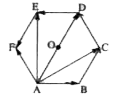In a regular hexagon ABCDEF,−−→AB+−−→AC+−−→AD+−−→AE+−−→AF=k−−→AD then k is equal to Solution in Gujrati
Step by step video & image solution for In a regular hexagon ABCDEF, vec(AB) +vec(AC)+vec(AD)+ vec(AE) + vec(AF)=k vec(AD) then k is equal to by Maths experts to help you in doubts & scoring excellent marks in Class 12 exams.
Updated on:21/07/2023Similar Questions
ABCDEF is a regular hexagon with point O as centre. Find the value of −−→AB+−−→AC+−−→AD+−−→AE+−−→AF

View SolutionABCDEF is a regular hexagon with point O as centre. Find the value of −−→AB+−−→AC+−−→AD+−−→AE+−−→AF

View SolutionABCDEF is a regular hexagon. Find the vector →AB+→AC+→AD+→AE+→AF in terms of the vector →AD
View SolutionABCDEF is a regular hexagon with point O as centre. Find the value of −−→AB+−−→AC+−−→AD+−−→AE+−−→AF

View SolutionABCDEF is a regular hexagon, Fig. 2 (c ) .65. What is the value of (vec (AB) + vec (AC) + vec (AD) + vec (AE) + vec (AF) ? .
View SolutionABCDEF is a regular hexagon with point O as centre. Find the value of vec(AB)+vec(AC)+vec(AD)+vec(AE)+vec(AF) .
View SolutionIn a regular hexagon ABCDEF, prove that −−→AB+−−→AC+−−→AD+−−→AE+−−→AF=3−−→AD
View SolutionConsider the regular hexagon ABCDEF with centre at O (origin). Five forces vec(AB), vec(AC), vec(AD), vec(AE), vec(AF) act at the vertex A of a regular hexagon ABCDEF. Then their resultant is
View Solution
